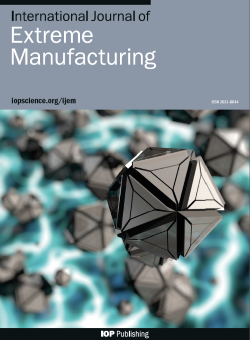Printability disparities in heterogeneous material combinations via laser directed energy deposition: a comparative study
IF 16.1
1区 工程技术
Q1 ENGINEERING, MANUFACTURING
引用次数: 0
Abstract
Additive manufacturing provides achievability for the fabrication of bimetallic and multi-material structures; however, the material compatibility and bondability directly affect the parts’ formability and final quality. It is essential to understand the underlying printability of different material combinations based on an adapted process. Here, the printability disparities of two common and attractive material combinations (nickel- and iron-based alloys) are evaluated at the macro and micro levels via laser directed energy deposition (DED). The deposition processes were captured using in situ high-speed imaging, and the dissimilarities in melt pool features and track morphology were quantitatively investigated within specific process windows. Moreover, the microstructure diversity of the tracks and blocks processed with varied material pairs was comparatively elaborated and, complemented with the informative multi-physics modeling, the presented non-uniformity in mechanical properties (microhardness) among the heterogeneous material pairs was rationalized. The differences in melt flow induced by the unlike thermophysical properties of the material pairs and the resulting element intermixing and localized re-alloying during solidification dominate the presented dissimilarity in printability among the material combinations. This work provides an in-depth understanding of the phenomenological differences in the deposition of dissimilar materials and aims to guide more reliable DED forming of bimetallic parts.通过激光定向能沉积异质材料组合的可印刷性差异:一项比较研究
增材制造可实现双金属和多材料结构的制造;然而,材料的兼容性和粘合性会直接影响零件的成型性和最终质量。了解不同材料组合在适应工艺基础上的基本可打印性至关重要。本文通过激光定向能沉积(DED)技术,从宏观和微观层面评估了两种常见且具有吸引力的材料组合(镍基合金和铁基合金)的可印刷性差异。利用原位高速成像技术捕捉了沉积过程,并定量研究了特定工艺窗口内熔池特征和轨迹形态的差异。此外,还对使用不同材料对加工的轨道和区块的微观结构多样性进行了比较阐述,并辅以翔实的多物理场建模,对异质材料对之间呈现的机械性能(显微硬度)不均匀性进行了合理解释。材料对不同的热物理性质引起的熔体流动差异,以及由此导致的元素混杂和凝固过程中的局部再合金化,主导了材料组合间印刷适性的差异。这项研究深入了解了异种材料沉积过程中的现象学差异,旨在为双金属零件更可靠的 DED 成形提供指导。
本文章由计算机程序翻译,如有差异,请以英文原文为准。
求助全文
约1分钟内获得全文
求助全文
来源期刊

International Journal of Extreme Manufacturing
Engineering-Industrial and Manufacturing Engineering
CiteScore
17.70
自引率
6.10%
发文量
83
审稿时长
12 weeks
期刊介绍:
The International Journal of Extreme Manufacturing (IJEM) focuses on publishing original articles and reviews related to the science and technology of manufacturing functional devices and systems with extreme dimensions and/or extreme functionalities. The journal covers a wide range of topics, from fundamental science to cutting-edge technologies that push the boundaries of currently known theories, methods, scales, environments, and performance. Extreme manufacturing encompasses various aspects such as manufacturing with extremely high energy density, ultrahigh precision, extremely small spatial and temporal scales, extremely intensive fields, and giant systems with extreme complexity and several factors. It encompasses multiple disciplines, including machinery, materials, optics, physics, chemistry, mechanics, and mathematics. The journal is interested in theories, processes, metrology, characterization, equipment, conditions, and system integration in extreme manufacturing. Additionally, it covers materials, structures, and devices with extreme functionalities.
 求助内容:
求助内容: 应助结果提醒方式:
应助结果提醒方式:


